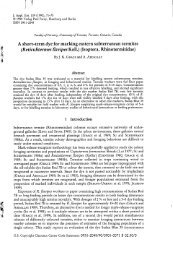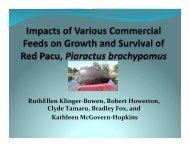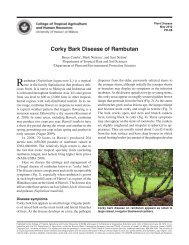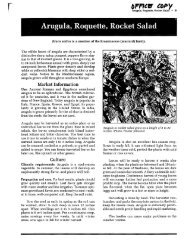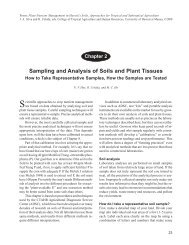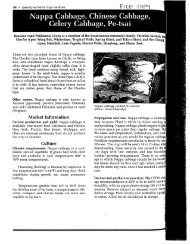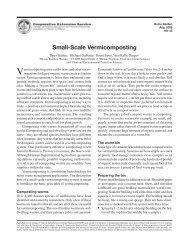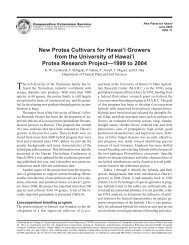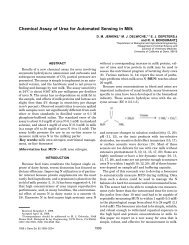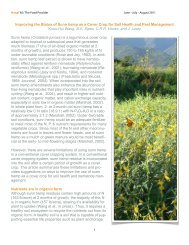Evaluation and Improvement of .ANTHURIUM CLONES - ctahr ...
Evaluation and Improvement of .ANTHURIUM CLONES - ctahr ...
Evaluation and Improvement of .ANTHURIUM CLONES - ctahr ...
Create successful ePaper yourself
Turn your PDF publications into a flip-book with our unique Google optimized e-Paper software.
TECHNICAL BULLETIN No. 58<br />
<strong>Evaluation</strong> <strong>and</strong> <strong>Improvement</strong> <strong>of</strong><br />
. <strong>ANTHURIUM</strong> <strong>CLONES</strong><br />
H.KAMEMOTO<br />
<strong>and</strong><br />
H. ·Y. NAKASONE<br />
JULY 1963<br />
HAWAII AGRICULTURAL EXPERIMENT STATION, UNIVERSITY OF HAWAII
EVALUATION OF ACCESSIONS.<br />
Yield<br />
Flower Color .<br />
Size, Shape, <strong>and</strong> Substance.<br />
Stem.<br />
Sucker Production .<br />
,CONTENTS<br />
Explanation <strong>of</strong> the <strong>Evaluation</strong> Table .<br />
Recommended Clones<br />
HYBRIDIZATION AND SELECTIION •<br />
GENETIC STUDIES .<br />
Spathe Color .<br />
Spadix Color .<br />
Double Spathe .<br />
Sucker Production.<br />
SELECTIONS INTRODUCED<br />
Uniwai .<br />
Marian Seefurth (H33) .<br />
PROMISING SELECTIONS .<br />
H17 .<br />
H19 .<br />
H84 .<br />
SUMMARY<br />
LITERATURE CITED .<br />
PAGE<br />
3<br />
3<br />
14<br />
14<br />
14<br />
16<br />
16<br />
17<br />
18<br />
20<br />
20<br />
24<br />
25<br />
25<br />
25<br />
26<br />
26<br />
27<br />
27<br />
27<br />
28<br />
28<br />
28
THE AUTHORS<br />
DR. H. KAMEMOTO is Horticulturist at the Hawaii Agricultural Experiment<br />
Station <strong>and</strong> Pr<strong>of</strong>essor <strong>of</strong> Horticulture, University <strong>of</strong> Hawaii.<br />
DR. H. Y. NAKASONE is Assistant Horticulturist at the Hawaii Agricultural<br />
Experiment Station <strong>and</strong> Assistant Pr<strong>of</strong>essor <strong>of</strong> Horticulture, University<br />
<strong>of</strong> Hawaii.
EVALUATION AND IMPROVEMENT OF <strong>ANTHURIUM</strong> <strong>CLONES</strong> 5<br />
houses <strong>of</strong>ten on valuable l<strong>and</strong>, in which return per unit area assumes great<br />
significance. An underst<strong>and</strong>ing <strong>of</strong> the normal growth <strong>and</strong> flowering behavior<br />
<strong>of</strong> the anthurium is essential in evaluating accessions on their capacity to<br />
produce flowers or to breed for increased yields.<br />
The Flower-The inconspicuous botanical flower is hermaphroditic, with<br />
a two-carpelled ovary <strong>and</strong> four anthers. The rudimentary perianth consists<br />
<strong>of</strong> four scale-like leaves. When mature, the stigma appears as a rounded<br />
protuberance on the spadix. Pollen is <strong>of</strong>ten shed long after the stigma<br />
becomes receptive, thereby preventing self-pollination. At the juncture <strong>of</strong><br />
the spadix <strong>and</strong> peduncle is found the colorful modified leaf called the spathe.<br />
In common usage, however, the "anthurium flower" refers to the complex<br />
<strong>of</strong> the spadix <strong>and</strong> spathe <strong>and</strong> <strong>of</strong>ten includes the peduncle, <strong>and</strong>, hence,<br />
this usage will be retained hereinafter unless specified otherwise.<br />
Normal Flowering Behavior-The anthurium produces flowers throughout<br />
the year, although there are differences in the rate <strong>of</strong> flowering depending<br />
upon the season. A flower emerges from each leaf axil. The sequence<br />
<strong>of</strong> leaf <strong>and</strong> flower production can be seen in figure I. In the cases <strong>of</strong> the<br />
varieties Kaumana <strong>and</strong> Nitta, the flowers emerge about a month after the<br />
leaves appear <strong>and</strong> precede the new leaves by a few weeks. This sequence in<br />
emergence is maintained throughout their growth, although the intervals<br />
between leaf emergence are shortened or lengthened, depending upon the<br />
environmental conditions. Thus, during the summer months when conditions<br />
are favorable for growth, more flowers can be expected than during<br />
the winter months when temperatures are lower <strong>and</strong> daylengths are shorter.<br />
Method <strong>of</strong> Determining Yield-Because only a few flowers are produced<br />
by a plant in a year <strong>and</strong> evaluation must <strong>of</strong>ten be based on the performance<br />
<strong>of</strong> a single plant, a suitable st<strong>and</strong>ard needs to be devised for the determination<br />
<strong>of</strong> yield. The following procedure has been adopted. At weekly intervals,<br />
the unfurling <strong>of</strong> the spathe <strong>of</strong> a new flower is recorded. The average<br />
interval in weeks between flowering is determined after 1 to 2 years <strong>of</strong> continuous<br />
observation. Then this average interval is divided into 52 weeks to<br />
arrive at the calculated number <strong>of</strong> flowers per plant per year. For example,<br />
if the first flower was recorded on January 15 <strong>and</strong> subsequent weekly intervals<br />
between flowering were 10, 9, 8, 7, 7, 8, <strong>and</strong> 9 weeks, the average weekinterval<br />
is 8 <strong>and</strong> this average divided into 52 weeks will give 6.5 flowers per<br />
plant per year. There is an experimental error due to making the observations<br />
on a weekly rather than on a daily basis. However, this error becomes<br />
relatively small if observations are continued for more than a year. If, on<br />
the other h<strong>and</strong>, yield were to be expressed by the actual number <strong>of</strong> flowers<br />
app'earing vvithin a calendar year, the first flower <strong>of</strong> a plant might be recorded<br />
on January 2 <strong>and</strong> the last flower on December 28, thereby giving a<br />
distorted yielding capacity for a plant.
16 HAWAII AGRICULTURAL EXPERIMENT STATION<br />
straight stems carrying the flowers above the foliage will prevent bruising<br />
during periods <strong>of</strong> strong winds.<br />
Sucker Production<br />
Differences in productivity <strong>of</strong> suckers are clearly evident among clones.<br />
Kaumana <strong>and</strong> Nitta are prolific producers <strong>of</strong> suckers. Because propagation<br />
from cuttings is very slow, a good commercial variety should produce suckers<br />
freely. However, an extreme proliferation <strong>of</strong> suckers may adversely affect<br />
flower production <strong>and</strong> become undesirable.<br />
Explanation <strong>of</strong> the <strong>Evaluation</strong> Table<br />
Table 1 lists the individual accessions with some pertinent information.<br />
The first column lists the accession numbers, <strong>and</strong> the third column the<br />
source. Most <strong>of</strong> these plants were generously donated at the outset <strong>of</strong> the<br />
research by the various people listed in column 3. The total number <strong>of</strong><br />
accessions evaluated to date is 113, but many accessions were not included<br />
in the table for several reasons. Some plants were discarded due to virus<br />
infection. Others did not thrive under the conditions <strong>of</strong> the experiment.<br />
Still others exhibited mediocre or poor performance <strong>and</strong> were not worthy<br />
<strong>of</strong> inclusion.<br />
The second column, "Recognized Varietal Name," lists only those clones<br />
that are commonly identified with horticultural names. For example, Kaumana,<br />
Nitta, Ozaki, <strong>and</strong> Kansako No. 1 are well known to practically all<br />
commercial growers.<br />
Five basic spathe colors are recorded. The term "Obake," as explained<br />
earlier, refers to a spathe with green chlorophyll development. The color<br />
<strong>of</strong> the spadix usually changes vvith maturity as mentioned earlier, but the<br />
designation is restricted to the initial color prior to the change.<br />
The measurements on spathe size, spadix length, <strong>and</strong> stem length are<br />
relative <strong>and</strong> only an approximation <strong>of</strong> the higher values obtained. Measurements<br />
will vary according to the size <strong>of</strong> plant, condition <strong>of</strong> plant, location,<br />
<strong>and</strong> season <strong>of</strong> year. The figures point out such information as the relatively<br />
small flowers <strong>of</strong> Kaumana; the long spadix <strong>of</strong> Accession 35, or the relatively<br />
long stems <strong>of</strong> Kansako No.1.<br />
The method <strong>of</strong> determining the yield in terms <strong>of</strong> number <strong>of</strong> flowers per<br />
plant per year was described earlier. In the second-from-the-Iast column,<br />
the yield is listed, together with a number in parentheses which is the number<br />
<strong>of</strong> weeks <strong>of</strong> continuous observations that entered into the calculation<br />
<strong>of</strong> the yield. The yield can be affected by cultural conditions <strong>and</strong>, therefore,<br />
these yield figures represent the highest yield obtained under the conditions<br />
<strong>of</strong> the experiment, <strong>and</strong> a yield that can be expected from the same<br />
clone in the future. It is highly possible that a clone with a low yield<br />
record listed in the table may, with improved cultural conditions, produce<br />
higher yields, but until such performance is actually recorded a higher<br />
yielding capacity is not proved.
18 HAWAII AGRICULTURAL EXPERIMENT STATION<br />
White:<br />
I. Acc. 13, Raga White. Very high yield (6.9 flowers), glossy, paperwhite<br />
spathe <strong>of</strong> good form <strong>and</strong> substance. Excessively large spadix<br />
with tendency toward fasciation (see fig. 4F) .<br />
HYBRIDIZATION AND SELECTION<br />
While the accessions were under observation <strong>and</strong> before any evaluations<br />
could be made, hybridizations were initiated. Later, when yield <strong>and</strong> other<br />
information gradually accumulated, pollinations were carefully planned.<br />
However, it has not always been possible to perform the desired pollination<br />
for either lack <strong>of</strong> pollen, or the synchronization <strong>of</strong> pollen availability <strong>and</strong><br />
stigma receptivity. The botanical flower is protogynous, the stigma becoming<br />
receptive soon after the unfurling <strong>of</strong> the spathe. The receptivity is generally<br />
correlated with a change in spadix color. The pollen, on the other<br />
h<strong>and</strong>, is <strong>of</strong>ten shed long after the opening <strong>of</strong> the spathe, although in small<br />
flowers from certain young seedlings the pollen is functional relatively early.<br />
The protogynous nature prevents selfing within a single spadix, <strong>and</strong> makes<br />
it necessary to have several plants <strong>of</strong> a clone to effect self-pollination.<br />
Some clones do not produce any pollen <strong>and</strong>, therefore, can be used only<br />
as seed-bearing parents.<br />
Young flowers with spathe still unfurled are covered with plastic bags<br />
to prevent contamination. Pollination is accomplished around 10 A.M. by<br />
grasping the pollen-ladened spadix with the fingers <strong>and</strong> then transferring<br />
the pollen to the stigmas <strong>of</strong> another flower by rubbing the spadix with the<br />
same fingers. If pollination <strong>and</strong> fertilization are consummated, the spadix<br />
gradually takes on a warty appearance, <strong>and</strong> finally after 6 to 7 months,<br />
mature two-carpelled, one- to two-seeded berries are obtained.<br />
r-rhe berries are collected <strong>and</strong> pressed in water with the fingers to separate<br />
the pulp <strong>and</strong> seed, the pulp is decanted, <strong>and</strong> the cleaned seeds are<br />
scattered on a medium <strong>of</strong> finely shredded tree-fern fiber in gallon-size containers<br />
<strong>and</strong> kept under relatively heavy shade (75 percent lath). These<br />
seeds germinate immediately; as a matter <strong>of</strong> fact, some seeds are viviparous,<br />
having developed a long radicle within the fruit.<br />
Four to 6 months after sowing, the seedlings are transplanted 2 to 3<br />
inches apart in flats containing a 5: I mixture <strong>of</strong> wood shavings <strong>and</strong> manure.<br />
Six to 8 months later, they are transplanted into 3-foot X 3-foot ground plots<br />
in five rows <strong>and</strong> five columns. As the seedlings come into flowering, flower<br />
color <strong>and</strong> other pertinent information are recorded. The seedlings can be<br />
expected to flower no sooner than I Y2 years after seeding, <strong>and</strong> orten 2Y2 to<br />
3 years are required for the majority <strong>of</strong> seedlings to come into flowering.<br />
Seedlings that show promising characteristics are singled out, given a<br />
selection number, planted in 3- to 5-gallon containers, <strong>and</strong> placed under<br />
critical observation. Often the shape <strong>of</strong> the flower changes with season<br />
<strong>and</strong> with increase in size <strong>and</strong> vigor <strong>of</strong> the plants, particularly those with a
FIGURE 4. A, Kaumana; B; Kansako No.1; C, Kansako No.2; D, Kozohara; E, Nitta; <strong>and</strong><br />
F, Raga White.
20 HAWAII AGRICULTURAL EXPERIMENT STATION<br />
tendency to produce Obake flowers. For this reason, many selections are<br />
eliminated during the course <strong>of</strong> observation <strong>and</strong> evaluation.<br />
Seedlings that have performed well are increased either in ground plots<br />
or in pots for further observations.<br />
Spathe Color<br />
GENETIC STUDIES<br />
One <strong>of</strong> the major objectives <strong>of</strong> the breeding program is to develop improved<br />
white- <strong>and</strong> pastel-colored varieties since these types are not readily<br />
available to the trade. Because breeding is greatly facilitated if the mode<br />
<strong>of</strong> inheritance is known, attempts to analyze the genetics <strong>of</strong> flower color<br />
were concurrently made with the breeding program.<br />
It requires 3 to 4 years to obtain a single generation <strong>and</strong> also, due to<br />
the limitations <strong>of</strong> facilities, only a limited number <strong>of</strong> progenies could be<br />
carried through at any period. Thus, the accumulation <strong>of</strong> genetic information<br />
has been slow.<br />
Red vs. Orange-In table 1 are presented the results obtained by selfing<br />
or crossing reds <strong>and</strong>/or oranges. A progeny <strong>of</strong> red X red gave all reds,<br />
although the population was very small. A red plant (Ace. 38) selfed, on<br />
the other h<strong>and</strong>, resulted in 44 red to 20 orange, which did not deviate significantly<br />
from a 3: 1 ratio. An orange plant selfed gave all orange flowers,<br />
although here again the population was very small. Two progenies <strong>of</strong> red X<br />
orange gave different results. Only reds arose from Acc. 15 X Acc. 41, while<br />
both reds <strong>and</strong> oranges were recovered from Ace. 97 X Ace. 98.<br />
From the above data the following conclusions might be drawn: (1) red<br />
is dominant to orange; (2) orange breeds true for orange, while red may<br />
give rise to either all red progeny or a mixed progeny <strong>of</strong> red <strong>and</strong> orange,<br />
depending upon whether the parent plant is homozygous or heterozygous;<br />
(3) crosses between red <strong>and</strong> orange can be expected to produce all red <strong>of</strong>fspring<br />
if the red parent is homozygous, or a I: I segregation <strong>of</strong> red <strong>and</strong><br />
orange if the red plant is heterozygous.<br />
Rr has been designated as the gene necessary for the production <strong>of</strong> red<br />
pigment <strong>and</strong> RO, for the orange pigment.<br />
The dominance <strong>of</strong> red over orange explains the preponderance <strong>of</strong> reds<br />
in a heterogenous group <strong>of</strong> seedlings.<br />
Red vs. White-When two whites were crossed, only whites were obtained,<br />
indicating that white is pure-breeding. Crossed to red, the <strong>of</strong>fsp-ring<br />
<strong>of</strong> three progenies segregated equally into red <strong>and</strong> coral pink (table 2).<br />
Since the red parent can be heterozygous for red <strong>and</strong> orange, as noted above,<br />
the 1: 1 segregation <strong>of</strong> red <strong>and</strong> coral pink is easily explained. Assuming that<br />
white is the rr genotype, the cross RrRo X rr will give Rrr <strong>and</strong> Ror, the<br />
former responsible for the red spathe <strong>and</strong> the latter for the coral pink spathe.<br />
It has not been possible to rule out the presence <strong>of</strong> two factors responsible<br />
for the colors, instead <strong>of</strong> a multiple-allele system. However, the results
EVALUATION AND IMPROVEMENT OF <strong>ANTHURIUM</strong> <strong>CLONES</strong> 21<br />
obtained to date strongly favor the multiple-allele system. It is proposed<br />
to clarify this by performing test crosses.<br />
It was postulated earlier (Kamemoto <strong>and</strong> Nakasone, 1955) on the basis<br />
<strong>of</strong> preliminary observations on flower color segregations that a cross between<br />
a red <strong>and</strong> a white should give pinks. It is now apparent that if the red<br />
parent is heterozygous, reds <strong>and</strong> coral pinks arise instead <strong>of</strong> rose pinks.<br />
TABLE 2. Segregation <strong>of</strong> flower color in selfs or crosses involving red <strong>and</strong> orange<br />
PARENTAGE<br />
RED ORANGE<br />
GENETIC<br />
RATIO<br />
Ace. 38 (red) X Ace. 14 (red) 6 1:0<br />
Ace. 38 (red) X self 44 20 3: 1 .25<br />
Ace. 97 (orange) X self 6 0:1<br />
Ace. 15 (orange) X Ace. 41 (red) 55 1:0<br />
Ace. 97 (orange) X Ace. 98 (red) 12 9 1: 1 .50<br />
TABLE 3. Seglcgation <strong>of</strong> flower color in crosses involving red <strong>and</strong> white<br />
PARENTAGE RED CORAL PINK WHITE<br />
Ace. 12 (white) X Ace. 13 (white) 56 0:0:1<br />
H13 (white) X H20 (white) 23 0:0:1<br />
H7 (white) X H25 (white) 47 0:0:1<br />
P<br />
GENETIC p<br />
RATIO<br />
H21 (white) X Ace. 66 (red) 44 34 1: 1:0 .25<br />
H21 (white) X Ace. 26 (red) 49 45 1: 1:0 .70<br />
Ace. 38 (red) X Ace. 63 (white) 28 34 1: 1:0 .45<br />
TABLE 4. Segregation <strong>of</strong> flower color in crosses involving orange, coral pink, <strong>and</strong> white<br />
PARENTAGE<br />
Ace. 15 (orange) IX Ace. 87 (coral pink)<br />
H21 (white) X Ace. 97 (orange)<br />
ORANGE<br />
85<br />
CORAL<br />
PINK<br />
57<br />
105<br />
WHITE<br />
GENETIC<br />
RATIO<br />
1:]:0<br />
0:1:0<br />
p<br />
.02
HAWAII AGRICULTURAL EXPERIMENT STATION<br />
Orange vs. Coral Pink VJ. White-An orange, selfed, produced all orange<br />
(table 2). When crossed to white, the <strong>of</strong>fspring were all coral pink (table<br />
4). When an orange was crossed to a coral pink, the progeny segregated<br />
into orange <strong>and</strong> coral pink <strong>of</strong>fspring. From these results orange can be assumed<br />
to be homozygous <strong>and</strong> coral pink to be heterozygous for the R 0 gene.<br />
The intensity <strong>of</strong> pigmentation among the <strong>of</strong>fspring <strong>of</strong> H21 X Acc. 97<br />
(white X orange) varied from light to dark, a few nearly approaching the<br />
intensity <strong>of</strong> the orange parent. Also, in the case <strong>of</strong> Ace. 15 X Ace. 87 (orange<br />
X coral pink), it was very difficult to classify the <strong>of</strong>fspring into the two<br />
categories because <strong>of</strong> an intergrading series <strong>and</strong>, consequently, the .02 P<br />
value obtained for a 1:.1 goodness <strong>of</strong> fit ,vas probably influenced by misclassification<br />
(table 4). It appears that modifying genes are also involved in<br />
the expression <strong>of</strong> color intensity in the orange-coral pink series. The two<br />
classes, therefore, are <strong>of</strong>ten arbitrary, having the same anthocyanin pigment<br />
but in varying concentration.<br />
Rose Opal vs. Coral Pink vs. White-Rose opal (022, Hort. Color Chart)<br />
is distinct from coral pink (0619, Hort. Color Chart), but the genetic relationship<br />
has not been clearly differentiated. Three crosses involving rose<br />
op,al <strong>and</strong> white have shed some light. As seen in table 5, the crosses segregated<br />
into white <strong>and</strong> nonwhite in equal proportions, indicating that the<br />
rose opal parent is heterozygous. The nonwhites can be classified into light<br />
coral pink <strong>and</strong> rose opal. A progeny <strong>of</strong> H21 (white) X H33 (pink) which<br />
was recently flowered <strong>and</strong> carefully observed revealed the following categories:<br />
White spathe with yellow spadix 10<br />
White spathe with red spadix 10<br />
Light coral pink with yello\v spadix 19<br />
Rose opal with red spadix - 12<br />
It appears that the spadix color interacts with the coral pink spathe to<br />
produce the rose opal color. That spadix color exhibits some influence on<br />
spathe color is evident in flowers with white spathe <strong>and</strong> red spadix. The<br />
major veins <strong>of</strong> the spathe radiating from the juncture <strong>of</strong> the spadix are<br />
<strong>of</strong>ten strongly colored. This color sometimes extends to the entire spathe,<br />
rendering a light pink appearance.<br />
Obake vs. Non-Obake-The nature <strong>of</strong> heritability <strong>of</strong> the Obake characteristic<br />
is difficult to establish, for the expression is affected by the size<br />
<strong>and</strong> vigor <strong>of</strong> the plant as well as by the season <strong>of</strong> the year. A young seedling<br />
with a fine-shaped, self-colored spathe may gradually develop Obake flowers<br />
as the plant matures, or if a young sucker <strong>of</strong> an Obake plant is propagated<br />
the first few flowers may be self-colored. Due to the dem<strong>and</strong>s on space in<br />
the lathhouse, it has not always been possible to retain a seedling population<br />
until full maturity in order to evaluate precisely the expression <strong>of</strong><br />
this characteristic.
EVALUATION AND IMPROVEMENT OF <strong>ANTHURIUM</strong> <strong>CLONES</strong><br />
In table 5 are listed the few progenies which were observed for the<br />
character. The selfed progenies <strong>of</strong> Ace. 97 <strong>and</strong> Acc. 38, both non-Obake<br />
types, were non-Obake, while progenies from Obake parents produced pre..<br />
dominantly Obake <strong>of</strong>fspring. H8 X Acc. 13, an Obake X non-Obake cross,<br />
gave Obake <strong>and</strong> non-Obake <strong>of</strong>fspring in nearly equal proportions. This<br />
might suggest a backcross ratio, since H8 itself has an Obake <strong>and</strong> non-<br />
Obake parentage.<br />
The large Obakes <strong>of</strong>ten comm<strong>and</strong> premium prices, but the dem<strong>and</strong> for<br />
these constitutes a small proportion <strong>of</strong> the anthuriums produced. Thus, in<br />
the breeding program, emphasis must be placed on the non-Obake types,<br />
<strong>and</strong> since the Obake character appears to be heritable, Obake should not<br />
be utilized in the breeding program unless improvement <strong>of</strong> Obake is spe..<br />
cifically intended.<br />
TABLE 5. Segregation <strong>of</strong> flower color in crosses between pink (rose opal) <strong>and</strong> white<br />
PARENTAGE WHITE NONWHITE*<br />
GENETIC<br />
RATIO<br />
H21 (white) X (pink) 20 31 1: 1 .10<br />
Ace. 11 (pink) X Ae
HAWAII AGRICULTURAL EXPERIMENT STATION<br />
'Spadix Color<br />
The spadix color changes with the maturity <strong>of</strong> the botanical flowers. A<br />
,common color is yellow changing to white when the botanical flowers<br />
mature, as indicated by the develop,ment <strong>of</strong> the stigmas. Other colors <strong>of</strong><br />
immature spadices before this change are red, purple, brown, gold, cream,<br />
<strong>and</strong> green, along with intergrading shades. Reddish spadices may remain<br />
Ted, or may change to purple or white.<br />
The spadix color has been classified into red or nonred (table 7). The<br />
expression <strong>of</strong> red color is not always complete, for many plants have been<br />
-observed to produce flowers with a red spadix <strong>and</strong> a nonred spadix at one<br />
time or another. Thus, in all crosses involving a red spadix, the few nonreds<br />
recorded might possibly be those that lacked penetrance. Red X red<br />
has given all <strong>and</strong> nearly all reds. Ace. 97 (orange spathe with a yellow<br />
:spadix) crossed to Ace. 98 (red spathe with a red spadix) gave all red<br />
spathes with red spadices, one red with yellow, <strong>and</strong> nine orange with yellow.<br />
In two crosses involving a red spathe with a red spadix <strong>and</strong> a white<br />
spathe with a yellow spadix, equal segregations <strong>of</strong> red spathes with red<br />
spadices <strong>and</strong> coral pink spathes with yellow spadices were obtained. It<br />
"seems that the orange <strong>and</strong> coral pink spathes generally suppress anthocyanin<br />
development, while red spathes appear to favor the development <strong>of</strong> red<br />
spadices.<br />
In the earlier section on inheritance <strong>of</strong> rose opal, it was noted that a<br />
-rose opal crossed to a white gave the four groups-vvhite with nonred spadix,<br />
white with red spadix, light coral pink with nonred spadix, <strong>and</strong> rose opal<br />
-with reu spadix in the approximate ratio <strong>of</strong> 1: I: 1: 1. It appears from this<br />
.<strong>and</strong> other crosses that spadix <strong>and</strong> spathe colors are independently inherited.<br />
TABLE 7. Segregation <strong>of</strong> spadix color<br />
PARENTAGE RED NONRED<br />
GENETIC<br />
RATIO<br />
Acc.95 (red) X Ace. 94 (red) 40 1:0<br />
Acc. 15 (nonred) X Acc. 41 (red) 50 5 1:0<br />
Ace. 97 (nonred) X Acc. 98 (red) II 1:0<br />
HI3 (red) X H20 (nonred) 14 9 I: I<br />
Acc. 13 (nonred) X pink (red) 22 21 I: I<br />
H2I (nonred) X H33 (nonred) 10 10 I: I<br />
Acc. 12 (nonred) X Acc. 13 (nonred) 56 0:1<br />
H7 (nonred) X H2.11 (nonred) 47 0:1<br />
p<br />
.30<br />
.85<br />
.99
EVALUATION AND IMPROVEMENT OF <strong>ANTHURIUM</strong> <strong>CLONES</strong> 25<br />
The <strong>of</strong>fspring <strong>of</strong> crosses involving white with either red or nonred spadices<br />
or the <strong>of</strong>fspring with white spathe from crosses <strong>of</strong> rose opal <strong>and</strong> white<br />
are convenient for the study <strong>of</strong> spadix color since interactions need not be<br />
concerned. All three crosses, H13 X H20, Ace. 13 X pink, <strong>and</strong> H21 X H33,.<br />
gave approximately a 1: 1 ratio for this character. The latter crosses both<br />
involved nonred spadices, but it is believed that the red spadix color <strong>of</strong> the<br />
rose opal parent (H33) has been suppressed. Further studies are necessary to<br />
clarify the mode <strong>of</strong> inheritance <strong>of</strong> spadix color as well as the possible interaction<br />
between spathe color <strong>and</strong> spadix color.<br />
Double Spathe<br />
Accession 94 has produced double spathes regularly, while Ace. 95 has<br />
thrown doubles sporadically (table 8). The cross between the two produced<br />
6 doubles, 8 occasional doubles, <strong>and</strong> 26 singles. Ace. 94 (double) X<br />
Ace. 97 (single), on the other h<strong>and</strong>, gave only 14 occasional doubles <strong>and</strong><br />
146 singles. Thus, doubleness is transmitted in varying degrees depending<br />
upon the parentage, with the percentage <strong>of</strong> doubles increasing if both<br />
parents are double. Figure 3D shows a good double-spathe variety.<br />
PARENTAGE<br />
.Acc. 95 X Ace. 94<br />
Ace. 94 X Ace. 97<br />
TABLE 8. Transmission <strong>of</strong> double spathe<br />
DOUBLES DOUBLES<br />
REGULARLY IRREGULARLY<br />
6 8<br />
14<br />
SINGLE<br />
26<br />
146<br />
TOTAL<br />
Sucker Production<br />
Observations on accessions have revealed clonal variation in the production<br />
<strong>of</strong> suckers. It was observed also that this character is generally transmitted<br />
to the <strong>of</strong>fspring. A high-suckering clone tended to produce <strong>of</strong>fspring<br />
with higher suckering capacity, while a low-yielding clone tended to produce<br />
few suckers. For example, seedlings <strong>of</strong> Kaumana or Nitta gave higher<br />
sucker yields than those <strong>of</strong> other crosses. Figure 5 shows Nitta, a highsuckering<br />
variety on the left <strong>and</strong> a low-suckering selection on the right.<br />
SELECTIO,NS INTRODUCED<br />
The first group <strong>of</strong> seedling selections made in 1953 totaled 34 plants, the<br />
second group made in 1955-56 nunlbered 22, <strong>and</strong> since then 126 additional<br />
selections were made. Several selections were discarded after preliminary<br />
evaluation because <strong>of</strong> inferior qualities. Continuous observation revealed<br />
two seedlings <strong>of</strong> exceptional merit among the early selections <strong>and</strong> these<br />
have been named for release to the trade.<br />
40<br />
160
26 HAWAII AGRICULTURAL EXPERIMENT STATION<br />
FIGURE 5. Plant on left shows numerous sucker growths from a single plant. Plant on right<br />
shows only the parent plant with no suckers. Both plants were repotted on the same date.<br />
Uniwai<br />
This selection with white flowers originated from a cross between Acc.<br />
12 <strong>and</strong> Acc. 13, both whites with very high yielding capacity. This seedling<br />
has shown an exceptionally high yield <strong>of</strong> 7.7 flowers per plant per year over<br />
a consecutive period <strong>of</strong> 101 weeks. The "veek intervals between flowering<br />
averaged only 6.7.<br />
The smooth <strong>and</strong> pliable white spathe is broad <strong>and</strong> heart-shaped with<br />
overlapping lobes (fig. 6A). During the spring months, the young spathes<br />
<strong>of</strong>ten develop a slight tinge <strong>of</strong> pink. The spadix is yellow, short, <strong>and</strong> drooping<br />
when young but turning upright with age. Sucker production is relatively<br />
poor. Thus, the flower characteristics are not outst<strong>and</strong>ing for exhibition<br />
purposes but this variety may have its place in cut-flower production.<br />
Since good commercial white varieties are uncommon, this exceptionally<br />
high yielder should be <strong>of</strong> interest <strong>and</strong> value to the grower.<br />
Marian Seefurth (H33)<br />
Emphasis in the breeding program has been placed on improving whites<br />
<strong>and</strong> pastels. The appearance <strong>of</strong> this seedling with attractive pink spathe
28 HAWAII AGRICULTURAL EXPERIMENT STATION<br />
H84<br />
This is a high-yielding white Obake with a broad, heart-shaped spathe<br />
measuring 8y! inches long <strong>and</strong> 7% inches wide. The spadix is yellow <strong>and</strong><br />
reclining. An <strong>of</strong>fspring <strong>of</strong> H7 <strong>and</strong> H25, it is a vigorous grower with an<br />
average yield <strong>of</strong> 6.7 flowers per plant per year (see fig. 3E) .<br />
SUMMARY<br />
Progress in anthurium breeding at the University <strong>of</strong> Hawaii since its<br />
inception in 1950 has been summarized.<br />
The accessions assembled from commercial establishments <strong>and</strong> private<br />
collections were observed <strong>and</strong> evaluated, <strong>and</strong> outst<strong>and</strong>ing clones for commercial<br />
production were singled out. Raga White, Nitta, Kaumana, Ozaki,<br />
Kansako No.1, <strong>and</strong> Hirose were among those evaluated favorably.<br />
Major emphasis in breeding has been placed on increased yields <strong>and</strong> on<br />
the imp-rovement <strong>of</strong> white- <strong>and</strong> pastel-colored forms. Two seedling selections<br />
were deemed worthy <strong>of</strong> naming <strong>and</strong> introducing into the trade. Selection<br />
H21, a white with exceptional yield, was named Uniwai. A second<br />
selection with excellent yielding capacity <strong>and</strong> an attractive rose opal spathe<br />
was named Marian Seefurth.<br />
The genetics <strong>of</strong> flower color was investigated. Red, Rr, appears to be<br />
dominant to orange, Ro; white, rr, breeds true for white. A red in heterozygous<br />
condition, RrRo, crossed to a white, rr, will give red, Rrr, <strong>and</strong> coral<br />
pink, Ror, in equal proportions. Orange, RoRo, crossed to white, rr, results<br />
in coral pink, Ror. Although the mode <strong>of</strong> inheritance <strong>of</strong> rose opal is not<br />
established, it is suggested that this color is a result <strong>of</strong> an interaction between<br />
coral pink, Ror, <strong>and</strong> a red spadix color.<br />
Red or nonred spadix color appears to be simply inherited <strong>and</strong> to interact<br />
to some extent with spathe color. Also, development <strong>of</strong> chlorophyll in<br />
the spathe seems to be simply inherited, but the transmission <strong>of</strong> sucker productivity<br />
<strong>and</strong> doubleness <strong>of</strong> spathe is not clearly defined.<br />
LITERATURE CITED<br />
BRITISH COLOUR COUNCIL IN COLLABORATION WITH THE ROYAL HORTICUL<br />
TURAL SOCIETY. 1938. HORTICULTURAL COLOUR CHART, VOLS. I AND II.<br />
KAMEMOTO, H., <strong>and</strong> H. Y. NAKASONE. 1953. EFFECT OF MEDIA ON PRODUC<br />
TION OF <strong>ANTHURIUM</strong>S. Hawaii Agric. Exp. Sta. Prog. Notes No. 94. 8 pp.<br />
<strong>and</strong> . 1955. IMPROVING <strong>ANTHURIUM</strong>S THROUGH BREEDING.<br />
Hawaii Farm Sci. 3 (3) : 4-5.<br />
NAKASONE, H. Y., <strong>and</strong> H. KAMEMOTO. 1957. WOOD SHAVINGS AS A MEDIUM<br />
FOR <strong>ANTHURIUM</strong>S. Hawaii Agric. Exp. Sta. Circ. 53. 11 pp.<br />
<strong>and</strong> . 1962. <strong>ANTHURIUM</strong> CULTURE WITH EMPHASIS ON THE<br />
EFFECTS OF SOME INDUCED ENVIRONMENTS ON GROWTH AND FLOWERING.<br />
Hawaii Agric. Exp. Sta. Tech. Bull. 50. 19 pp.
UN:IVERSITY OF HAWAII<br />
COLLEGE OF TROPICAL AGRICULTURE<br />
HAWAII AGRICULrURAL EXPERIMENT STATION<br />
HONOLULU, HAWAII<br />
THOMAS H. HAMILTON<br />
President <strong>of</strong> the University<br />
MORTON M. ROSENBERG<br />
Dean <strong>of</strong> the College <strong>and</strong><br />
Director <strong>of</strong> the Experiment Station<br />
G. DONALD SHERMAN<br />
Associate Director <strong>of</strong> the Experiment Station



